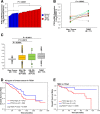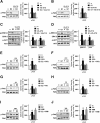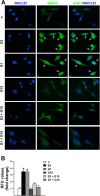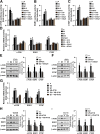Focal adhesion kinase (FAK) activation by estrogens involves GPER in triple-negative breast cancer cells
- PMID: 30728047
- PMCID: PMC6364402
- DOI: 10.1186/s13046-019-1056-8
Focal adhesion kinase (FAK) activation by estrogens involves GPER in triple-negative breast cancer cells
Abstract
Background: Focal adhesion kinase (FAK) is a cytoplasmatic protein tyrosine kinase that associates with both integrins and growth factor receptors toward the adhesion, migration and invasion of cancer cells. The G-protein coupled estrogen receptor (GPER) has been involved in the stimulatory action of estrogens in breast tumor. In this study, we have investigated the engagement of FAK by GPER signaling in triple negative breast cancer (TNBC) cells.
Methods: Publicly available large-scale database and patient data sets derived from "The Cancer Genome Atlas" (TCGA; www.cbioportal.org ) were used to assess FAK expression in TNBC, non-TNBC tumors and normal breast tissues. MDA-MB 231 and SUM159 TNBC cells were used as model system. The levels of phosphorylated FAK, other transduction mediators and target genes were detected by western blotting analysis. Focal adhesion assay was carried out in order to determine the focal adhesion points and the formation of focal adhesions (FAs). Luciferase assays were performed to evaluate the promoters activity of c-FOS, EGR1 and CTGF upon GPER activation. The mRNA expression of the aforementioned genes was measured by real time-PCR. Boyden chamber and wound healing assays were used in order to evaluate cell migration. The statistical analysis was performed by ANOVA.
Results: We first determined by bioinformatic analysis that the mRNA expression levels of the gene encoding FAK, namely PTK2, is higher in TNBC respect to non-TNBC and normal breast tissues. Next, we found that estrogenic GPER signaling triggers Y397 FAK phosphorylation as well as the increase of focal adhesion points (FAs) in TNBC cells. Besides, we ascertained that GPER and FAK activation are involved in the STAT3 nuclear accumulation and gene expression changes. As biological counterpart, we show that FAK inhibition prevents the migration of TNBC cells upon GPER activation.
Conclusions: The present data provide novel insights regarding the action of FAK in TNBC. Moreover, on the basis of our findings estrogenic GPER signaling may be considered among the transduction mechanisms engaging FAK toward breast cancer progression.
Keywords: FAK; G-15; GPER; MDA-MB 231; STAT3, STA21; SUM159; TNBC; VS-4718.
Conflict of interest statement
Ethics approval and consent to participate
Not applicable.
Consent for publication
Not applicable.
Competing interests
The Authors declare that they have no conflict of interest. N.N. is an employee of MSD K.K., a subsidiary of Merck & Co., Inc. and reports personal fees from MSD K. K outside this study.
Publisher’s Note
Springer Nature remains neutral with regard to jurisdictional claims in published maps and institutional affiliations.
Figures









Similar articles
-
GPER mediates enhanced cell viability and motility via non-genomic signaling induced by 17β-estradiol in triple-negative breast cancer cells.J Steroid Biochem Mol Biol. 2014 Sep;143:392-403. doi: 10.1016/j.jsbmb.2014.05.003. Epub 2014 May 27. J Steroid Biochem Mol Biol. 2014. PMID: 24874276
-
Bisphenol A induces focal adhesions assembly and activation of FAK, Src and ERK2 via GPER in MDA-MB-231 breast cancer cells.Toxicol In Vitro. 2020 Aug;66:104871. doi: 10.1016/j.tiv.2020.104871. Epub 2020 Apr 20. Toxicol In Vitro. 2020. PMID: 32325111
-
Overexpression of the miR-141/200c cluster promotes the migratory and invasive ability of triple-negative breast cancer cells through the activation of the FAK and PI3K/AKT signaling pathways by secreting VEGF-A.BMC Cancer. 2016 Aug 2;16:570. doi: 10.1186/s12885-016-2620-7. BMC Cancer. 2016. PMID: 27484639 Free PMC article.
-
Estrogen Actions in Triple-Negative Breast Cancer.Cells. 2020 Oct 26;9(11):2358. doi: 10.3390/cells9112358. Cells. 2020. PMID: 33114740 Free PMC article. Review.
-
G-Protein Coupled Estrogen Receptor in Breast Cancer.Int J Mol Sci. 2019 Jan 14;20(2):306. doi: 10.3390/ijms20020306. Int J Mol Sci. 2019. PMID: 30646517 Free PMC article. Review.
Cited by
-
Focal Adhesion Kinase (FAK)-Hippo/YAP transduction signaling mediates the stimulatory effects exerted by S100A8/A9-RAGE system in triple-negative breast cancer (TNBC).J Exp Clin Cancer Res. 2022 Jun 3;41(1):193. doi: 10.1186/s13046-022-02396-0. J Exp Clin Cancer Res. 2022. PMID: 35655319 Free PMC article.
-
Picturing Breast Cancer Brain Metastasis Development to Unravel Molecular Players and Cellular Crosstalk.Cancers (Basel). 2021 Feb 22;13(4):910. doi: 10.3390/cancers13040910. Cancers (Basel). 2021. PMID: 33671551 Free PMC article.
-
The G Protein-Coupled Estrogen Receptor (GPER) Expression Correlates with Pro-Metastatic Pathways in ER-Negative Breast Cancer: A Bioinformatics Analysis.Cells. 2020 Mar 4;9(3):622. doi: 10.3390/cells9030622. Cells. 2020. PMID: 32143514 Free PMC article.
-
FOXF1 inhibits invasion and metastasis of lung adenocarcinoma cells and enhances anti-tumor immunity via MFAP4/FAK signal axis.Sci Rep. 2024 Sep 13;14(1):21451. doi: 10.1038/s41598-024-72578-7. Sci Rep. 2024. PMID: 39271782 Free PMC article.
-
GPER as a Receptor for Endocrine-Disrupting Chemicals (EDCs).Front Endocrinol (Lausanne). 2020 Aug 19;11:545. doi: 10.3389/fendo.2020.00545. eCollection 2020. Front Endocrinol (Lausanne). 2020. PMID: 32973678 Free PMC article. Review.
References
MeSH terms
Substances
Grants and funding
LinkOut - more resources
Full Text Sources
Other Literature Sources
Molecular Biology Databases
Research Materials
Miscellaneous

